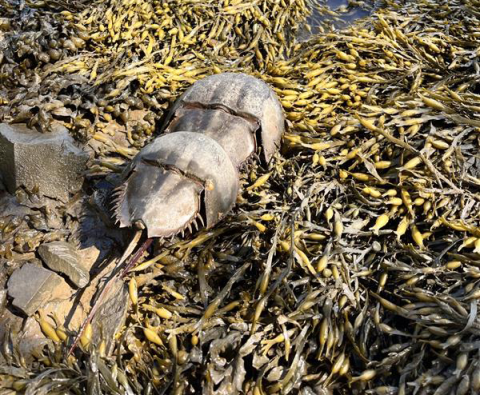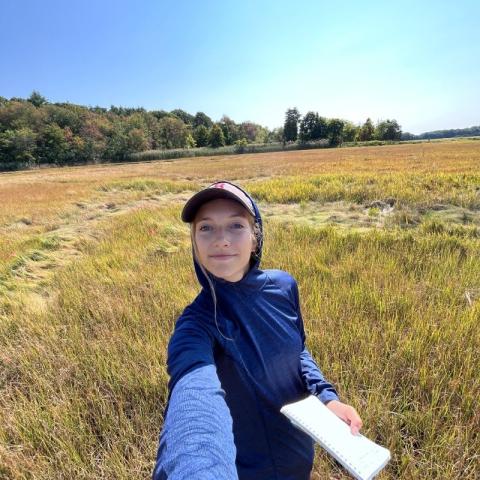Lauren White, UNH Alum, Uses Her Participatory Science Skills In New Career

Every spring, there is a gathering at the hightide line of the Great Bay in New Hampshire. From the depths of the estuary, horseshoe crabs creep up from the murky depths to find mates, lay eggs, and then return to the mud. From the land, dozens of volunteers descend to bear witness to this event, tromping through the chilly estuarine water to count the crabs. Over the past 10 years, participatory scientists have contributed thousands of observations from these spawning surveys at multiple sites throughout the Great Bay.
In January, Lauren White (G ’24) joined the Great Bay National Estuarine Research Reserve (GBNERR) as a Biologist. The Great Bay is Lauren’s old friend. As a research assistant in David Burdick’s lab at UNH, she spent many summer days in these estuarine marshes studying eelgrass habitat loss and opportunities for coastal resiliency. During her graduate studies, Lauren gained invaluable experiences that contributed to her current role with GBNERR. Her coursework, such as Easton White’s Data Science with R for Life Sciences, helped Lauren build confidence with managing large datasets and working with the programming language necessary for conducting analyses. Through working on a master’s thesis, Lauren was prepared to work on long-term projects that require patience and foresight. And she built a network of wonderful mentors, collaborators, and colleagues that made her feel even more connected to the region. “I went to the NH Sea Grant symposium recently, and it was really nice to walk into this room of professionals and recognize so many people. I’ve built this network through classes I took, my lab, the people my advisor connected me with, and the people I collaborated with.” These connections with people and the land gave Lauren the confidence to apply for her current role with GBNERR.

In her role at GBNERR, Lauren helps wrangle years of participatory science data, analyze results, and interpret findings for the Great Bay Horseshoe Crab Monitoring Project. “Everything we work on is a collaboration,” she said of GBNERR. The horseshoe crab monitoring project involves researchers from UNH, Plymouth State University, and New Hampshire Fish and Game, while the outreach wing of GBNERR leverages their volunteer network to gather data. Without the dedicated volunteers, this project would not exist. It requires “a level of time, effort, and resources that would be impossible to do without a dedicated team of people."
It might seem odd that so many people want to volunteer their time to count spawning horseshoe crabs, but Lauren isn’t surprised. “The people living on our small coastline are really invested in the environment and care for it.” Many of the long-term volunteers on this project have become “site captains”, acting as local experts and offering guidance and helpful tips to new volunteers. While many volunteers come back year-after-year, the project always welcomes new and excited individuals to spend some time with the crabs. If you want to learn more about this awesome project or find out about volunteering, reach out to volunteer coordinator Melissa Brogle, Melissa.R.Brogle@wildlife.nh.gov.
About the Author: Mairi Poisson (she/her) is a PhD student in the UNH Natural Resources and Earth System Sciences program. She studies the impacts of human development on wildlife. After taking GRAD 834: Foundations of Citizen and Community Science, Mairi became more involved with the efforts of the UNH Participatory Science Working Group where she now provides support for advancing participatory science efforts at UNH.

